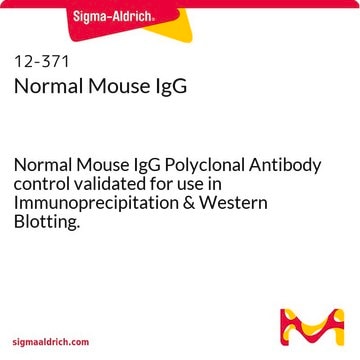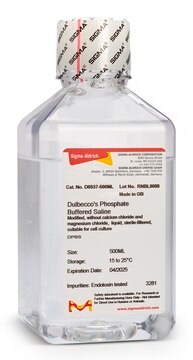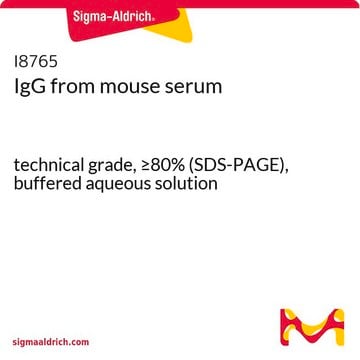11333151001
Roche
Mouse IgG ELISA
Synonyme(s) :
quantification kit for hybridomas | hybridoma quantification | monoclonal quantification
Se connecterpour consulter vos tarifs contractuels et ceux de votre entreprise/organisme
About This Item
Code UNSPSC :
12352200
Produits recommandés
Utilisation
sufficient for ≤400 tests
Fabricant/nom de marque
Roche
Technique(s)
ELISA: suitable
Conditions d'expédition
wet ice
Température de stockage
2-8°C
Description générale
An accurate determination of immunoglobulin levels in the hybridoma-culture supernatant is essential to study the effect of drugs or physical parameters on hybridoma growth, or the level of immunoglobulin secretion.
Assay time: Approximately 2.5 - 4.5 hours
Sample material: Hybridoma supernatant, ascites, mouse sera, and purified IgG preparations (the assay is not applicable for the quantification of IgG preparations purified with strongly denaturing buffers, for example, during the elution from affinity chromatrography matrices)
Sensitivity: Approximately 10 ng IgG/ml
Assay time: Approximately 2.5 - 4.5 hours
Sample material: Hybridoma supernatant, ascites, mouse sera, and purified IgG preparations (the assay is not applicable for the quantification of IgG preparations purified with strongly denaturing buffers, for example, during the elution from affinity chromatrography matrices)
Sensitivity: Approximately 10 ng IgG/ml
Enzyme immunoassay for the determination of mouse IgG in mouse hybridoma supernatant and ascites.
Immunoglobulin G (IgG) belongs to the immunoglobulin family and is a widely expressed serum antibody. Each immunoglobulin has two heavy chains and two light chains connected by a disulfide bond. It mainly helps in immune defense. It is a glycoprotein. Mouse IgG is further divided into five classes- IgG1, IgG2a, IgG2b and IgG3.
Spécificité
The mouse IgG ELISA shows no cross-reactivity with other Ig classes from mouse or bovine IgG (<0.1%).
Application
The kit can be used for the determination of mouse IgG in hybridoma supernatants, ascites, mouse sera, etc.
Actions biochimiques/physiologiques
Immunoglobulin G (IgG) participates in hypersensitivity type II and type III reactions. IgG2a has cytotropic properties and IgG2 molecules have the ability to activate the complement system. IgG helps in opsonization, complement fixation and antibody dependent cell mediated cytotoxicity.
Caractéristiques et avantages
- Reliable: Highly specific antibodies supplied with the kit
- Easy: Follows a standard ELISA protocol
- Fast: Results in 2 - 4 hours
- Sensitive: Detects down to 10 ng/ml
- Highly specific: No crossreactivity with FBS
Conditionnement
1 kit containing 9 components.
Principe
The Mouse IgG ELISA follows a standard sandwich ELISA protocol. First, a special capture antibody is bound to the wells of the microplate. The antibody used is an optimized mixture of immunosorptively purified, polyclonal anti-mouse IgG from sheep, which possesses equivalent affinity to all IgG subclasses (including IgG3). After blocking with post-coating buffer, the mouse IgG, contained in the sample to be assayed (e.g., hybridoma supernatant, ascites dilution), is bound to the capture antibody. Next, a balanced mixture of anti-mouse-λ- and anti-mouse-κ-antibodies (immunosorptively purified Fab fragments), conjugated to POD, is added and bound to the mouse IgG. In the next step, the POD substrate ABTS is added and metabolized to form a colored reaction product. The absorbance of the sample is determined with a microplate (ELISA) reader, then compared with the absorbance values of a reference curve. A standard solution to produce a calibration curve is provided with the kit.
Notes préparatoires
Working solution: Preparation of Standard Solution
After complete reconstitution, pipette 10 aliquots (50 μl each) into the remaining 10 empty vials, close tightly.
Storage conditions (working solution): Standard Solution
Stable for several months when stored in aliquots at -15 to -25 °C; avoid more than three freeze/thaw cycles.
- Open standard carefully to avoid loss of lyophilizate material. Add exactly 500 μl double-distilled water. Note: On the label of vial 5, the contents of IgG per vial are provided in mg/fl (flask). Since the contents of the vial are dissolved in 0.5 ml, the IgG concentration (in mg/ml) will be exactly twice the value printed on the label after reconstitution.
- Close the bottle carefully. Allow to the bottle to equilibrate at 15 to 25 °C for 30 minutes. Then dissolve the contents of the bottle completely by gentle swirling. Note: Avoid the formation of foam, and do not shake.
After complete reconstitution, pipette 10 aliquots (50 μl each) into the remaining 10 empty vials, close tightly.
Storage conditions (working solution): Standard Solution
Stable for several months when stored in aliquots at -15 to -25 °C; avoid more than three freeze/thaw cycles.
Autres remarques
For life science research only. Not for use in diagnostic procedures.
Composants de kit seuls
Réf. du produit
Description
- Coating Antibody, anti-mouse-IgG
- Coating Buffer Concentrate
- Detergent
- Blocking Reagent
- Standard
- Conjugate, optimized mixture of anti-mouse-k-POD antibody and anti-mouse-l-POD antibody
- Substrate Buffer
- ABTS Substrate Tablets
- 20 empty vials, for the preparation of the standard dilutions
Afficher tout (9)
Mention d'avertissement
Danger
Mentions de danger
Conseils de prudence
Classification des risques
Aquatic Chronic 3 - Eye Dam. 1 - Skin Sens. 1
Code de la classe de stockage
11 - Combustible Solids
Classe de danger pour l'eau (WGK)
WGK 2
Point d'éclair (°F)
230.0 °F
Point d'éclair (°C)
110 °C
Faites votre choix parmi les versions les plus récentes :
Déjà en possession de ce produit ?
Retrouvez la documentation relative aux produits que vous avez récemment achetés dans la Bibliothèque de documents.
Les clients ont également consulté
The Laboratory Rat (1998)
Molecular Genetics of Immunoglobulin, 17 (1987)
The Immunoglobulins: Structure and Function (1998)
Micha Drukker et al.
Methods in molecular biology (Clifton, N.J.), 407, 63-81 (2008-05-06)
Differentiated cell types derived from human embryonic stem cells (hESCs) may serve in the future to treat various human diseases and to model early human embryonic development in vitro. Fulfilling this potential, however, requires extensive development of methods and reagents
Antibody structure, instability, and formulation.
Wang W
Journal of Pharmaceutical Sciences, 96(1), 1-26 (2007)
Notre équipe de scientifiques dispose d'une expérience dans tous les secteurs de la recherche, notamment en sciences de la vie, science des matériaux, synthèse chimique, chromatographie, analyse et dans de nombreux autres domaines..
Contacter notre Service technique
















